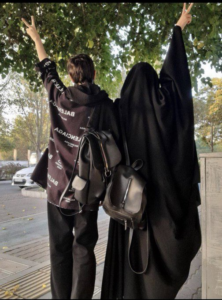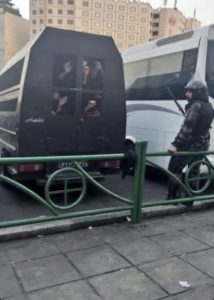Minds of the Movement
An ICNC blog on the people and power of civil resistance
by Seyedeh Faezeh AlaviOctober 27, 2022
The 1979 Islamic Revolution overthrew the monarchy of Iran, and an Islamic dictatorship was established in its place. Over the ensuing four decades, people have nonviolently defied the regime and challenged its policies. However, because of the lack of communication channels with the free world, combined with the military power of the regime, the people have not been able to spread their voices. Until now...
On September 16, 2022, Mahsa Amini, a 22-year-old woman, died in custody of the Morality Police after being detained for allegedly breaking the law requiring women to wear the hijab. According to Mahsa’s family, she had even been wearing a headscarf and was arrested only because some strands of her hair were showing.
Mahsa’s family courageously spoke out against the police’s actions. At her funeral, her grandfather wrote on her grave: “Mahsa, your name will be a symbol”, which indeed it has been. The story of Mahsa’s death broke nationally thanks to her family and friends’ bravery to speak out against the Iranian government’s policies. In the days following Mahsa’s death, Iranians gradually started protesting in the streets and spreading the news of her death using the limited communication avenues available to them. They made their voices heard internationally, which is a testament to the fact that when people decide they want to be free, they cannot be silenced.
As we marked yesterday the symbolic 40th day of grieving Mahsa's death, her passing continues to rally Iranians against the regime's oppression of its own people, especially women. What Iranians want now is not only changes to the mandatory hijab law, but also for political freedoms to be restored to the people more broadly. The movement is demanding that a secular democratic regime be established. It is not the first women’s movement in the country’s history, but it is arguably the largest one in scale thus far.
There are currently heavy restrictions on independent and foreign reporting in Iran. For this article, I relied on sources on the ground as well as outlets that Iranians generally view as reliable, such as 1500tasvir and Iran International TV. Since the beginning of the movement, Iranians inside the country have been sending, when possible, their photos, videos and information to these outlets.
One solution, revolution: Participants, notable tactics

Iran, September 2022. Credit: Author's anonymous source.
Although both men and women have been oppressed by the Iranian regime, women’s rights have been severely restricted in the name of Islam. As such, the main leading group of this movement is women, notably taking their headscarves off at protests to show they want freedom.
One remarkable characteristic of this movement is that the majority of the protesters are under 30 years old. These young people are quitting school and removing portraits of regime leaders from school walls. Like the women without headscarves in public, they are not afraid of being killed by the Iranian police.
Ordinary people in rural areas, and not just educated elites in urban areas, have been participating in actions. Although there are recurring internet blackouts, the media outlets named above are still able to receive pieces of information from these areas and announce them with a few days’ delay (I discuss social media below).
Some national athletes announced that they no longer want to compete for the Islamic Republic, in protest of the regime’s brutality. A few examples include Arezou Izadi, the goalkeeper of the Iranian national ice hockey team, and Razieh Janbaz, a handball competitor. On October 16, Elnaz Rekabi, a female rock climber, competed for Iran in South Korea without a headscarf while (she later claimed on Instagram that it was unintentional). Concerns about her situation are already increasing because the Islamic Republic is known to coerce confessions.
Some singers have been releasing new songs in support of the movement, such as Shervin and his song “Baraye”. Nevertheless, we are seeing reports of dissenting musicians and famous figures being arrested.
The petroleum industry is an important part of the Iranian economy. Workers of oil companies are going on strike as part of the recent mobilization. Dozens of oil workers in Asalouyeh, a town on the Persian Gulf coast, went on strike a few weeks into the uprising and set up roadblocks near petrochemical plants. Although officials are claiming that the strike is a labor dispute, workers themselves state they have common grievances with the broader movement.
The Council of Oil Contract Workers announced on October 10 that more than 4,000 workers were striking, affecting sites elsewhere along the Persian Gulf coast. With oil production at a halt in many areas of the country because of the recent strikes, it is becoming clearer by the day that industrial action will be the new battleground between the people and the regime.
Although it is difficult to know whether or not groups are coordinating (i.e. women protesting and oil workers), what we do know is that the Council of Oil Contract Workers is already making public statements to denounce regime repression of protesters. "We will stop working and join the people if you continue killing and arresting people in their protest against compulsory hijab," the Council said in a recent statement. "We, the workers of the oil projects, in unison with people in Iran, once again declare our anger and hatred towards the murder of Mahsa Amini at the hands of the morality police. We support the people's fight against organized crimes against women, and growing poverty," it added.
International acts of solidarity
Iranians outside the country are asking governments to expel Iranian regime officials to support the movement and to weaken the Islamic Republic. The Iranian diaspora, people with diverse occupations such as lawyers and politicians are organizing gatherings and coordinating groups inside the country (the groups are either using VPNs or managing to connect during rare times that the internet has been made accessible again). Their actions focus on amplifying unfiltered information, for example, protest dates and times to other people they know in Iran who might participate, or contacting celebrities for international support.
Indeed, many international celebrities have been supporting Iranians, notably by cutting their hair, one of the movement’s symbolic actions. Women all over the world, including famous French actresses like Juliette Binoche and Marion Cotillard, have posted videos of themselves cutting their hair to support Iranians. The act shows the viciousness of being killed only because of a few strands of hair.
The international hacking group Anonymous and others are orchestrating cyberattacks on Iranian officials and government websites as a way to assist the movement. As officials shut down access to WhatsApp, Instagram, and other social media platforms, hackers also began assisting citizens to bypass internet censorship to help amplify voices calling for freedom.
Repression and other challenges

Iran forces arrest protesters of Mahsa's death, September 2022. Credit: Author's anonymous source.
The regime is using all of its power to oppress people. Nevertheless, many analysts and activists including Morad Vaisi, a researcher and journalist for Iran International TV, and Hossein Ronaghi, a freedom of speech activist (who was recently arrested in conjunction with repression of ongoing protests) say that the regime is in a very weak state, that it has lost its authority among the people. Although the estimated number of people who have been killed due to police repression seems lower than in previous movements, we do know that Iranian forces are killing protesters in Zahedan, Kurdistan and other areas. They are reportedly arresting students in schools. However, a lack of news coverage from the ground makes it difficult to know the details.
One of the challenges the movement faces is that some journalists in the Iranian diaspora who are connected to the regime are mischaracterizing the protests in foreign media. This undeniably influences Western media narratives about the revolution and so far has functioned as a barrier for Western countries to take direct action to support Iranians. For example, Farnaz Fasihi, a journalist for The New York Times has been characterizing the grievances as economic in nature, arguing that sanctions will only hurt the Iranian people, not the regime.
Early trends and directions
The protests are scattered on most days but become concentrated on certain days. The resistance is gradually becoming more coordinated over time; for example, when the regime kills more innocent people in different cruel ways, people get angrier, the number of protesters increases, and they plan more actions. Gradually, people are getting a better idea of which media outlets and which activists are the most reliable. So, the information from reliable sources is becoming more viral among more and more diverse groups of people. Based on sources in the country and on news accounts of oil workers uniting with protesters, I believe that activists and groups are becoming more united and beginning to coordinate actions.
Right now, the future of Iran and political goals after this regime are the primary focus of movement actors. And in fact, they’ve been working on this for several years, not only in the past few weeks. For sure, the main goals are a secular democratic government (which would involve the ouster of the current regime) and the suppression of the hijab law.
Based on what I have heard, people are united behind a nonviolent strategy, and violence is only being promoted by the regime. For example, we hear that the regime is committing mass killings in Kurdistan and trying to provoke the people of Kurdistan (both Iraq and Iran) into war. The regime would then be able to show the world that Kurdistan wants to be separated from Iran and claim that that’s why people are protesting! But the people of Kurdistan are aware of these malicious intentions. We know they are trying to defend themselves, though so far, I can only confirm cases of setting fire to the Iranian police cars, which I would not consider nonviolent.
What we can expect in the coming weeks
Today, we have enough evidence that numbers of protesters are growing quickly. According to some estimates, participation reached 8 million people on October 8, just three weeks after Mahsa’s death.
We can also expect petroleum workers’ strikes to grow in breadth and intensity, which could further weaken the regime. Protests are decentralized, which has surely made repression sparser than we might otherwise expect, despite the many lives already lost.
While many people are openly defying the regime, others are fighting back in various creative ways. For example, some people are putting red dye in the ponds of city squares to underscore the blood the regime has shed—of women and other nonviolent freedom fighters. Still others are giving gifts to the women who are bravely walking in the streets without headscarves.
Let us hope that creativity, ingenuity and solidarity will have a multiplier effect and that participation will expand both within the country and internationally. I have done, and will continue to do, my part, and I hope you will, too.

Seyedeh Faezeh Alavi
Seyedeh Faezeh Alavi is an Iranian activist, artist, and MA student in Development Policy at KDI School of Public Policy and Management, South Korea. She is currently working on Human Rights and Sustainable Social Development at iHuman, an NGO that focuses on personal, organizational, and social development, mainly in Iran.
Read More